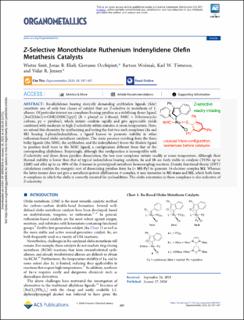| dc.contributor.author | Smit, Wietse | |
| dc.contributor.author | Ekeli, Jonas Brattebø | |
| dc.contributor.author | Occhipinti, Giovanni | |
| dc.contributor.author | Wozniak, Bartosz | |
| dc.contributor.author | Törnroos, Karl Wilhelm | |
| dc.contributor.author | Jensen, Vidar Remi | |
| dc.date.accessioned | 2021-05-21T13:38:38Z | |
| dc.date.available | 2021-05-21T13:38:38Z | |
| dc.date.created | 2020-05-26T23:50:03Z | |
| dc.date.issued | 2020 | |
| dc.Published | Organometallics. 2020, 39 (3), 397-407. | |
| dc.identifier.issn | 0276-7333 | |
| dc.identifier.uri | https://hdl.handle.net/11250/2756073 | |
| dc.description.abstract | Ru-alkylidenes bearing sterically demanding arylthiolate ligands (SAr) constitute one of only two classes of catalyst that are Z-selective in metathesis of 1-alkenes. Of particular interest are complexes bearing pyridine as a stabilizing donor ligand, [RuCl(SAr)(═CHR)(NHC)(py)] (R = phenyl or 2-thienyl, NHC = N-heterocyclic carbene, py = pyridine), which initiate catalysis rapidly and give appreciable yields combined with moderate to high Z-selectivity within minutes at room temperature. Here, we extend this chemistry by synthesizing and testing the first two such complexes (5a and 5b) bearing 3-phenylindenylidene, a ligand known to promote stability in other ruthenium-based olefin metathesis catalysts. The steric pressure resulting from the three bulky ligands (the NHC, the arylthiolate, and the indenylidene) forces the thiolate ligand to position itself trans to the NHC ligand, a configuration different from that of the corresponding alkylidenes. Surprisingly, although this configuration is incompatible with Z-selectivity and slows down pyridine dissociation, the two new complexes initiate readily at room temperature. Although their thermal stability is lower than that of typical indenylidene-bearing catalysts, 5a and 5b are fairly stable in catalysis (TONs up to 2200) and offer up to ca. 80% of the Z-isomer in prototypical metathesis homocoupling reactions. Density functional theory (DFT) calculations confirm the energetic cost of dissociating pyridine from 5a (= M1-Py) to generate 14-electron complex M1. Whereas the latter isomer does not give a metathesis-potent allylbenzene π-complex, it may isomerize to M1-trans and M2, which both form π-complexes in which the olefin is correctly oriented for cycloaddition. The olefin orientation in these complexes is also indicative of Z-selectivity. | en_US |
| dc.language.iso | eng | en_US |
| dc.publisher | American Chemical Society | en_US |
| dc.rights | Navngivelse 4.0 Internasjonal | * |
| dc.rights.uri | http://creativecommons.org/licenses/by/4.0/deed.no | * |
| dc.title | Z-Selective Monothiolate Ruthenium Indenylidene Olefin Metathesis Catalysts | en_US |
| dc.type | Journal article | en_US |
| dc.type | Peer reviewed | en_US |
| dc.description.version | publishedVersion | en_US |
| dc.rights.holder | Copyright 2020 American Chemical Society | en_US |
| cristin.ispublished | true | |
| cristin.fulltext | original | |
| cristin.qualitycode | 2 | |
| dc.identifier.doi | 10.1021/acs.organomet.9b00641 | |
| dc.identifier.cristin | 1812753 | |
| dc.source.journal | Organometallics | en_US |
| dc.source.40 | 39 | |
| dc.source.14 | 3 | |
| dc.source.pagenumber | 397-407 | en_US |
| dc.relation.project | Notur/NorStore: NS2506K | en_US |
| dc.relation.project | Notur/NorStore: NN2506K | en_US |
| dc.relation.project | Norges forskningsråd: 239288 | en_US |
| dc.relation.project | Norges forskningsråd: 226244 | en_US |
| dc.relation.project | Norges forskningsråd: 208335 | en_US |
| dc.identifier.citation | Organometallics. 2020, 39 (3), 397–407 | en_US |
| dc.source.volume | 39 | en_US |
| dc.source.issue | 3 | en_US |

